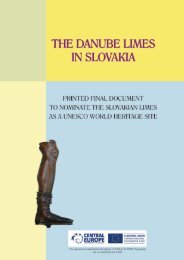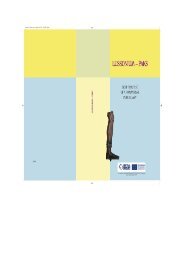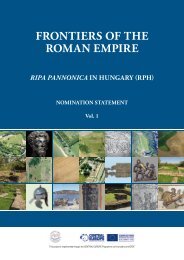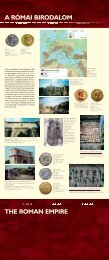DEFiNitiON, DEScRiPtiON ANd MAPPiNG OF ... - Danube Limes
DEFiNitiON, DEScRiPtiON ANd MAPPiNG OF ... - Danube Limes
DEFiNitiON, DEScRiPtiON ANd MAPPiNG OF ... - Danube Limes
Sie wollen auch ein ePaper? Erhöhen Sie die Reichweite Ihrer Titel.
YUMPU macht aus Druck-PDFs automatisch weboptimierte ePaper, die Google liebt.
11. Dunabogdány – Váradok-dűlő<br />
KÖH id. nr.: 10205<br />
Cirpi<br />
Only one excavation has been performed<br />
on this fort, in 1930 Ákos Szalay studied its<br />
eastern corner, but with the aid of the evidence<br />
on the surface and aerial photographs, he was<br />
able to publish the full ground plan of the fort<br />
as well. The fort was 124×147 m in size, with<br />
1.2 meter thick walls.<br />
The first camp was a structure made of<br />
earth and wood, constructed in the year 80<br />
during the time of the pannonian proconsul<br />
Titus Atilius Rufus according to its construction<br />
inscription. It was rebuilt as a stone fort in the<br />
middle of the 2 nd century, using the earlier ditch<br />
for the foundations of the walls. One of the<br />
interior corner towers is known, and its<br />
dimensions are 2×2.2 m. The camp was altered<br />
during the time of Constantine (306-337) or<br />
Constantine II (337-340), which is when the<br />
horseshoe shaped and fan shaped corner towers<br />
were built onto it. In the 4 th century a 17×16.5 m<br />
trapezoidal tower was erected in place of the<br />
fort.<br />
Significant remains of the fort are<br />
concealed underground. The site rises<br />
significantly above its surroundings, and a brief<br />
section of the original camp wall is even visible.<br />
The area of the camp is not cultivated, and it is<br />
neglected and overgrown. The countless holes<br />
dug by treasure hunters looking for metal show<br />
that the remains are being constantly destroyed.<br />
Boundaries of core and buffer zones:<br />
The core zone is the property border that<br />
encloses the remains of the fort that rise above<br />
the surroundings. The buffer zone contains the<br />
known extent of the settlement (vicus) that<br />
developed around the fort along the borders of<br />
the properties involved, which do not however<br />
correspond with the actual boundaries of<br />
cultivation.<br />
34<br />
Bibliography:<br />
SZALAY 1933.<br />
TÓTH 1978, 181-191.<br />
24. The southern side of the fort. The remains of the fort<br />
stand above the surroundings even today<br />
(Photo: Dénes Jankovich-Bésán)<br />
25. The neglected, overgrown area at the interior of the<br />
fort (Photo: Dénes Jankovich-Bésán)<br />
26. The ground plan of the fort<br />
(Digitalization: PTE)











